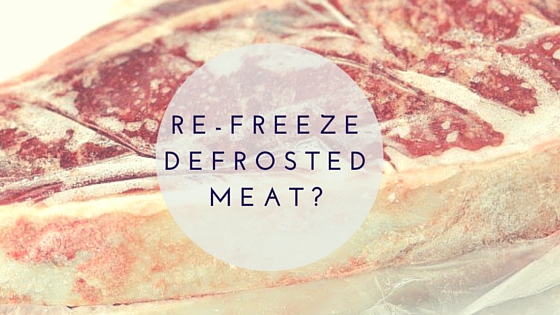Contrary to how grocery shopping is done in parts of Europe, where you buy fresh meat and vegetables every few days to be eaten quickly, in the U.S. it’s often more common to buy meat in bulk and freeze it until you need it. Freshness aside, it’s not a bad idea and it’s certainly a good way to conserve money – especially since you can get a better deal per pound than you would if you bought a steak or two every couple of days.
However, when you freeze meat you face other issues about quality and food safety. For example, once you fully defrost meat, can you refreeze it safely?
Can I Refreeze Defrosted Meat?
Before we talk about whether or not meat is ok to eat after you freeze it, defrost it, and then re-freeze it, it’s important to understand what the process of freezing does to food. When you freeze meat, some of the cell walls are destroyed, which allows moisture to be released. Then, once the food is thawed, it becomes more susceptible to bacteria, which is a big no-no for food safety. Refreezing the meat again destroys more cell walls and releases even more moisture, which dries out the meat and makes it lose some of its flavor and nutrient content.
With all of that said, the USDA actually says that its ok to refreeze meat, so long as it has been defrosted in the refrigerator. It won’t be as good, when you finally end up cooking it, but it should be safe to eat. If you thaw the meat out in running water or in the microwave, however, it’s better not to refreeze it for future cooking.
Despite the fact that frozen meat can be thawed in the fridge and then re-frozen and eaten safely doesn’t change the fact that it’s not the greatest idea. If you value the flavor of your food, it’s much better to just eat whatever meat you’ve thawed instead of freezing it again for later. Meat will lose a lot of flavor and texture through multiple freezes, and given that, we never encourage eating it after multiple freezes.
How to Correctly Defrost Meat
There are three correct ways to defrost meat for cooking. The first (and most preferable way) is to move the meat from the freezer into the refrigerator and let it thaw completely on its own. Usually, this takes the better part of a day, or you can move the meat into the fridge before you go to bed, and it’ll probably be done by lunch time the next day. The reason this way is best is because it keeps meat under 40 degrees Fahrenheit while its defrosting, which helps keep bacteria away.
If time is a factor, and you have an hour to thaw out meat for dinner, the best option is to put the meat in a plastic bag and run cool water over it. This helps keep the temperature consistent while it’s defrosting, but helps it thaw out more quickly. Usually two steaks can be thawed completely within an hour. You can also put the bagged steaks in a small bowl and leave them submerged in cool water.
If an hour of defrosting just won’t cut it, there is one emergency measure you can take and that’s defrosting in the microwave. To defrost meat in the microwave, remove whatever packaging it’s in and place it on a microwavable safe plate. Keep in mind, if you use this method, you need to cook the meat immediately after. Use your microwave’s defrost settings to properly defrost meat without cooking it a little (a common issue when defrosting in the microwave). To be safe, check the meat periodically while you’re defrosting it to ensure that it isn’t heating up too much and is defrosting without cooking.
Do you have any tips for defrosting meat or using meat after it’s been defrosted and refrozen? Share with us in the comments!






Thank you for the great information!
Our Pleasure Maggie! Thanks for stopping in and commenting!
The type of microwave makes a big difference. Regular microwaves, when set at low power or defrost still run at full power, but for short amounts of time. If I remember correctly, if you, for example, set 40%, it will run at full power for 40% of each minute (but it may not do it all at once, it may do it in shorter bursts). Good chance of actually cooking the item. But if you have a microwave with an inverter, like mine, when you set 40%, it runs at 40% power, not full. Much easier to defrost without cooking part of your item. I ususally defrost at 20%, but you still have to watch it. Otherwise, in a bag, in water works well too. Keep sumbmerged with a weight. The inverter is also great for reheating meat without making it tough.